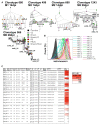Single-cell BCR and transcriptome analysis after influenza infection reveals spatiotemporal dynamics of antigen-specific B cells
- PMID: 34161770
- PMCID: PMC7612943
- DOI: 10.1016/j.celrep.2021.109286
Single-cell BCR and transcriptome analysis after influenza infection reveals spatiotemporal dynamics of antigen-specific B cells
Erratum in
-
Single-cell BCR and transcriptome analysis after influenza infection reveals spatiotemporal dynamics of antigen-specific B cells.Cell Rep. 2022 Nov 29;41(9):111764. doi: 10.1016/j.celrep.2022.111764. Cell Rep. 2022. PMID: 36450255 No abstract available.
Abstract
B cell responses are critical for antiviral immunity. However, a comprehensive picture of antigen-specific B cell differentiation, clonal proliferation, and dynamics in different organs after infection is lacking. Here, by combining single-cell RNA and B cell receptor (BCR) sequencing of antigen-specific cells in lymph nodes, spleen, and lungs after influenza infection in mice, we identify several germinal center (GC) B cell subpopulations and organ-specific differences that persist over the course of the response. We discover transcriptional differences between memory cells in lungs and lymphoid organs and organ-restricted clonal expansion. Remarkably, we find significant clonal overlap between GC-derived memory and plasma cells. By combining BCR-mutational analyses with monoclonal antibody (mAb) expression and affinity measurements, we find that memory B cells are highly diverse and can be selected from both low- and high-affinity precursors. By linking antigen recognition with transcriptional programming, clonal proliferation, and differentiation, these finding provide important advances in our understanding of antiviral immunity.
Keywords: B cells; antibodies; antiviral immunity; germinal center; influenza; memory B cells; single-cell BCRseq; single-cell RNA-seq.
Copyright © 2021 The Author(s). Published by Elsevier Inc. All rights reserved.
Conflict of interest statement
Declaration of interests The authors declare no competing interests.
Figures








References
Publication types
MeSH terms
Substances
Grants and funding
LinkOut - more resources
Full Text Sources
Medical
Miscellaneous

